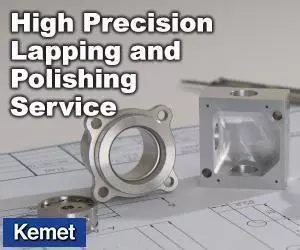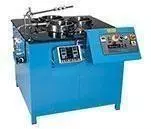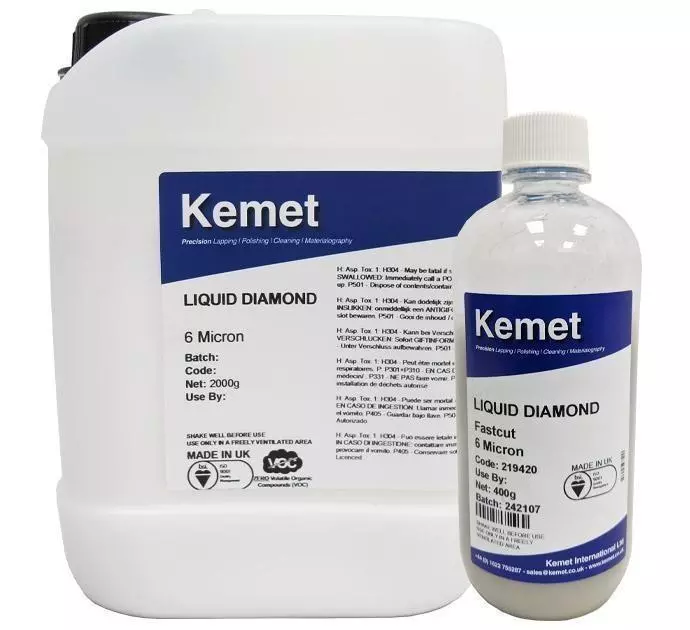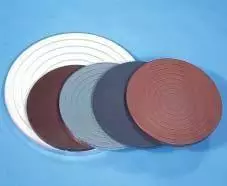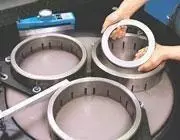Lapping and Polishing Mechanical Seal Faces
Common types of Mechanical Seal Face:
Carbon, Tungsten Carbide, Ceramic, Silicon Carbide, Chrome Oxide, Stellite, Ni-Resist and Phosphor Bronze.
Machine lapping is the production method of lapping Mechanical Seal Faces. Kemet Lapping Systems are used in both manufacturing and reconditioning processes. The following techniques are applicable to Bench Mounted and Free Standing Machines, as well as Kemet Hand Lapping Systems.
The machine size to be used would normally be determined by the largest seal to be lapped. For example, a Kemet 15 machine could lap seals up to approximately 125mm diameter (5”), whereas a Kemet 24 machine would be required if seals up to 200mm (8”) diameter were to be lapped. In most cases, if the following procedures are adopted, it should be possible to produce high quality reflective surfaces flat to less than 2LB.(0.0006mm)
Many materials used for the manufacture of mechanical seals are now too hard to be lapped using old fashioned conventional abrasives like aluminium oxide and silicon carbide. A Kemet composite lapping plate with a diamond slurry will generate a good cutting rate, and a highly reflective surface finish meaning a secondary polishing stage is not needed.
Kemet Flat Lapping Systems are available to fit most Lapping Machines up to 72” diameter, but for the majority of seal repair workshops 15” or 24” machines are adequate.
Any conventional Lapping Machine can be converted to a Kemet Diamond System by simply substituting the existing plate with a suitable Kemet Plate and fitting the appropriate Kemet Spray System. Existing control rings are still used, but require chamfers on their outer edges to assist diamond impregnation of the Kemet Plate. Once a machine is converted the lapping/polishing process is fully automatic.
As the processing capability of the Kemet System is so efficient, very little is used in the way of Diamond slurry. The high consumable usage, common to conventional lapping does not occur and the disposal of this waste material is therefore no longer a problem.
Lapping Plate Flatness
Flat Mechanical Seals can only be produced on flat lapping plates. It is therefore essential to regularly check plate flatness. This is the most important skill to master when operating a flat lapping machine.
Typical Kemet dispenser settings when lapping mechanical seals and valves
| 15” machine | 24” machine | ||
|---|---|---|---|
| Diamond | Fluid | Diamond | Fluid |
| 2 seconds Duration 20 seconds Interval | 1 second Duration 120 seconds Interval | 2 seconds Duration 20 seconds Interval | 2 seconds Duration 40 seconds Interval |
The dispenser should be set to spray at the above intervals with the individual air regulators at the back of the Diamond Dispenser both set to 1/2bar (7.5 PSI). The lapping plate should first be charged for 10 minutes by running the machine and applying the above spray quantities.
It is important to ensure when lapping or polishing that the lapping plate is neither too wet nor too dry. If the plate is too wet, the diamond becomes flooded by lubricant and the stock removal will be very low; if the plate is too dry, the parts can come into direct contact with the lapping plate, and this will negatively affect the resulting surface finish and cause the plate to heat up.
Seals can then be lapped by placing them inside the machine’s control rings and applying a pressure. If multiple parts are to be lapped inside the same conditioning ring, it is essential that they are the same thickness (+/- 0.5mm). To keep the parts in position during lapping either a work-holder, (sometimes called a nest), should be manufactured. This is typically a 3mm disc of Tufnell with the profile of the parts to be lapped machined into it. Alternatively the pressure weights themselves can be faced with a Kemet Facing Kit. This special material has non-skid properties that hold the parts in position during lapping without the need for a work-holder.
Single seals may be allowed to run freely inside a control ring, but it is important to apply a weight to obtain optimum stock removal. This weight should be balanced. An ideal weight is a large steel ball that can simply be placed on top of the seal. It is also recommended that a rubber band be placed around single seals as this gives them drive within the control rings, thus avoiding tracking on the lapping plate. .
Suggested approximate pressure applications
| Carbon 100g/cm² | Tungsten Carbide 300g/cm² | Silicon Carbide 200g/Cm² | Ceramic 600g/Cm² |
| Nickel Iron 200g/Cm² | Stellite 200g/Cm² | Chrome Oxide 300g/Cm² | Spray Coated 200g/Cm² |
If a large seal is to be lapped on a relatively small lapping machine, then it is possible to remove a control ring and substitute the seal, which will then run in the Roller Yoke Assembly.
Creating a Convex Surface on a Mechanical Seal Face
During any lapping operation, the parts being lapped will mirror the shape of the lapping plate. It’s for this reason that lapping plates are generally maintained in an extremely flat condition (typically less than 0.004mm) so that the parts being lapped will mirror this flatness.
For some applications, a convex surface is required, so in these instances, the lapping plate must be conditioned so that it is concave before you begin lapping parts. A concave lapping plate will create a convex part because the part mirrors the plate.
The amount of concavity needed will depend on the convexity required, and the size and surface area of the parts to be lapped.
- To create a concave lapping plate, position all the conditioning rings as far towards the centre of the plate as is possible.
- Use Kemox 0400-S, or suitable conventional abrasive slurry to generate the concavity. Do not use not diamond.
- Do not lap parts until the concavity has been generated. Start by conditioning the plate until it is 0.020mm concave.
- Once this concavity has been generated, clean the plate and rings, and then charge the plate with the appropriate Kemet diamond slurry for the application.
- Lap a part as normal inside the conditioning ring.
- Check the flatness of the part, and adjust the plate shape as necessary.
Creating the concavity can take a long time, so if in production, we recommend keeping a plate specifically for this convex face generation. Ideally a dedicated set of conditioning rings would be kept with the plate.
Kemet will calculate the exact shape plate required for concave/convex lapping operations. We also offer contract lapping services and Free testing
Lapping & Polishing Carbon
Test Requirements: To find a suitable lapping process for spring loaded carbon seals.
Component/Material: 4 x spring loaded carbon seals
Machine Type: Kemet 15 lapping machine
Parts were lapped for 10 minutes on the diamond lapping machine and then lapped by hand on the Kemet Copper plate until they were polished. Hand lapping took up to 30 seconds. As the parts were spring loaded the parts had to be put on top of an optical flat to get a light band reading. rather than putting an optical flat on top of the seal.
| Lapping Process for Carbon | |||
|---|---|---|---|
| Stage | Plate/cloth type | Abrasive type/grade | Process time |
| 1 | Kemet Copper | Kemet Liquid diamond 3 micron type k std | 10 minutes |
